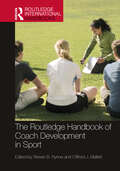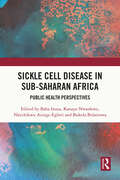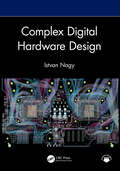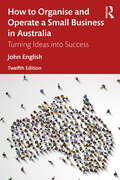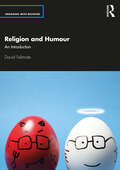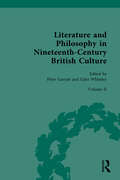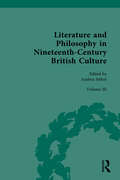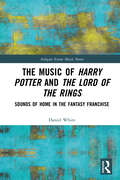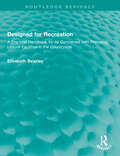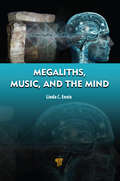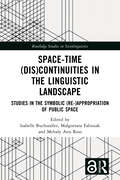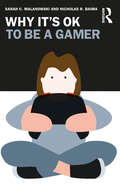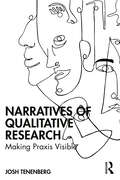- Table View
- List View
The Routledge Handbook of Coach Development in Sport (Routledge International Handbooks)
by Steven B. Rynne Clifford J. MallettThe Routledge Handbook of Coach Development in Sport is a comprehensive text that underscores the importance of learning and context for those who sculpt the environment in which people of all ages develop in and through sport.Coaches and those responsible for the development of coaches are best positioned as both learners and facilitators of learning. As sport becomes more globalised, the concomitant professionalisation of coaches necessitates ongoing learning and development to embrace new knowledge and understanding. Moreover, contemporary coach development presents as a wicked problem, in that it continues to evolve, it is contextually bound, and there is no single or obvious way to approach it. Problematically, there is often limited assistance available to support coaches and coach developers in their ongoing development. As such, this book provides a truly international reference point that brings together leading scholars and practitioners from across the globe to provide an overview of the theories and practices of coaches and coach developers that are impacting the quality of sporting environments.Therefore, this book is an important reference for researchers, scholars, and practitioners alike in the fields of Sport Coaching, Coach Development, Sport Development, Sport for Development, Physical Education and related disciplines.
Sickle Cell Disease in Sub-Saharan Africa: Public Health Perspectives
by Baba Inusa Kanayo Nwankwo Nkechikwu Azinge-Egbiri Bukola BolarinwaThis fascinating collection examines the socio-economic factors that impact the well-being of patients with sickle cell disease (SCD) in Sub-Saharan Africa and the critical importance of patient advocacy in the region.The book looks at a number of key issues, including the social determinants that influence the spread of the disease, the quality of life of children with SCD, the impact of stigma and the broader psychosocial burden of such a prevalent condition. There are also chapters on policy and Public Health management, including collaborations with non-governmental organisations (NGOs) and global partners.The second in a two-volume set offering a multi-disciplinary perspective on SCD, this insightful collection highlights many of the hidden issues faced across the region. It will be important reading for students of both Public Health and Medicine, as well as practitioners working for governments or NGOs.
Sickle Cell Disease in Sub-Saharan Africa: Public Health Perspectives
by Baba Inusa Kanayo Nwankwo Nkechikwu Azinge-Egbiri Bukola BolarinwaThis fascinating collection examines the socio-economic factors that impact the well-being of patients with sickle cell disease (SCD) in Sub-Saharan Africa and the critical importance of patient advocacy in the region.The book looks at a number of key issues, including the social determinants that influence the spread of the disease, the quality of life of children with SCD, the impact of stigma and the broader psychosocial burden of such a prevalent condition. There are also chapters on policy and Public Health management, including collaborations with non-governmental organisations (NGOs) and global partners.The second in a two-volume set offering a multi-disciplinary perspective on SCD, this insightful collection highlights many of the hidden issues faced across the region. It will be important reading for students of both Public Health and Medicine, as well as practitioners working for governments or NGOs.
Complex Digital Hardware Design
by Istvan NagyThis book is about how to design the most complex types of digital circuit boards used inside servers, routers and other equipment, from high-level system architecture down to the low-level signal integrity concepts. It explains common structures and subsystems that can be expanded into new designs in different markets.The book is targeted at all levels of hardware engineers. There are shorter, lower-level introductions to every topic, while the book also takes the reader all they way to the most complex and most advanced topics of digital circuit design, layout design, analysis, and hardware architecture.
Complex Digital Hardware Design
by Istvan NagyThis book is about how to design the most complex types of digital circuit boards used inside servers, routers and other equipment, from high-level system architecture down to the low-level signal integrity concepts. It explains common structures and subsystems that can be expanded into new designs in different markets.The book is targeted at all levels of hardware engineers. There are shorter, lower-level introductions to every topic, while the book also takes the reader all they way to the most complex and most advanced topics of digital circuit design, layout design, analysis, and hardware architecture.
How to Organise and Operate a Small Business in Australia: Turning Ideas into Success
by John EnglishYou have an idea for a business, but you’re not sure where to begin. Or perhaps you have made a start, but you’re not sure what to do next. It’s a common dilemma shared by everyone who has been down the same path. Where can I go for help? What are my legal obligations? How do I start making sales? How can I use digital marketing? How do I organise my operations? What’s involved in employing staff? How do I handle my finances?How to Organise and Operate a Small Business in Australia is your hands-on guide to running your own business. This new 12th edition contains information, skills, and ideas that are up to date, easy to understand, and simple to use. It reflects fundamental changes that have taken place as a result of the pandemic and the surge in small business digital technology. A feature of this new edition is a series of reflective exercises designed to help you evaluate your business ideas for their commercial potential.Used by tens of thousands of Australians to become self-employed, this new 12th edition is the most comprehensive small business handbook in Australia. An essential read for anyone who wants to have a business of their own.
How to Organise and Operate a Small Business in Australia: Turning Ideas into Success
by John EnglishYou have an idea for a business, but you’re not sure where to begin. Or perhaps you have made a start, but you’re not sure what to do next. It’s a common dilemma shared by everyone who has been down the same path. Where can I go for help? What are my legal obligations? How do I start making sales? How can I use digital marketing? How do I organise my operations? What’s involved in employing staff? How do I handle my finances?How to Organise and Operate a Small Business in Australia is your hands-on guide to running your own business. This new 12th edition contains information, skills, and ideas that are up to date, easy to understand, and simple to use. It reflects fundamental changes that have taken place as a result of the pandemic and the surge in small business digital technology. A feature of this new edition is a series of reflective exercises designed to help you evaluate your business ideas for their commercial potential.Used by tens of thousands of Australians to become self-employed, this new 12th edition is the most comprehensive small business handbook in Australia. An essential read for anyone who wants to have a business of their own.
The Social Nature of Antibiotic Overprescription in China: Medical Conversations, Doctor–Patient Relationships, and Decision-Making (Routledge Studies in Language, Health and Culture)
by Nan Christine WangOffering a rarely seen glimpse into the realities of one of the biggest global public health crises in modern time, Wang’s book focuses on doctor–patient interactions in China to demonstrate the potential effects of health communication, doctor–patient relationship, and a matrix of social factors on overprescription of antibiotics.Based on a community-based survey, the book describes empirical findings regarding the high prevalence of non-prescribed antibiotics use for common colds among children in China. It covers the potential effects of overprescription on caregivers' attitudes and how physicians make prescribing decisions in medical consultations. Drawing from evidence in medical interaction data, readers are introduced to further empirical findings regarding the communicative behaviors that patient caregivers use to pressure for antibiotic prescriptions in real medical consultations. Following this, Wang reports findings regarding the communicative behaviors that physicians use to make treatment recommendations and caregivers use to launch treatment negotiations, leading to a discussion of the effect of the doctor–patient relationship on antibiotic overprescription. The book culminates in practice recommendations and provides teaching scenarios in which physicians successfully engage the caregivers into conversations to shape their expectations for antibiotic prescriptions in medical consultations.An important resource for scholars and students in health communication, linguistics, medical humanities, and medical sociology. Practitioners who are interested in understanding and improving clinical practices as well as policymakers aiming to combat antibiotic resistance will also find this book useful.
The Social Nature of Antibiotic Overprescription in China: Medical Conversations, Doctor–Patient Relationships, and Decision-Making (Routledge Studies in Language, Health and Culture)
by Nan Christine WangOffering a rarely seen glimpse into the realities of one of the biggest global public health crises in modern time, Wang’s book focuses on doctor–patient interactions in China to demonstrate the potential effects of health communication, doctor–patient relationship, and a matrix of social factors on overprescription of antibiotics.Based on a community-based survey, the book describes empirical findings regarding the high prevalence of non-prescribed antibiotics use for common colds among children in China. It covers the potential effects of overprescription on caregivers' attitudes and how physicians make prescribing decisions in medical consultations. Drawing from evidence in medical interaction data, readers are introduced to further empirical findings regarding the communicative behaviors that patient caregivers use to pressure for antibiotic prescriptions in real medical consultations. Following this, Wang reports findings regarding the communicative behaviors that physicians use to make treatment recommendations and caregivers use to launch treatment negotiations, leading to a discussion of the effect of the doctor–patient relationship on antibiotic overprescription. The book culminates in practice recommendations and provides teaching scenarios in which physicians successfully engage the caregivers into conversations to shape their expectations for antibiotic prescriptions in medical consultations.An important resource for scholars and students in health communication, linguistics, medical humanities, and medical sociology. Practitioners who are interested in understanding and improving clinical practices as well as policymakers aiming to combat antibiotic resistance will also find this book useful.
Religion and Humour: An Introduction (Engaging with Religion)
by David FeltmateThis timely and lively introduction to exploring the intersection of religion and humour evaluates existing scholarship and methodologies within the field, arguing for a culturally critical approach to the study.Hinged on a qualitative sociological framework, this book asks questions about the construction, presentation, and purpose of humour in religious contexts. It is broken down by theoretical approach, with chapters covering: a “comparative religions” approach; a theological approach; how social sciences offer us useful tools for research; and a review of existing theoretical models. As the first volume to introduce the field of religion and humour, this engaging book is essential reading for students approaching the topic for the first time, and for anyone with an interest in related fields such as religion and popular culture and humour studies.
Literature and Philosophy in Nineteenth-Century British Culture: Volume II: The Mid-Nineteenth Century
by Peter Garratt Giles WhiteleyThis is the second volume in a three-volume collection of primary sources which examines philosophy and literature in nineteenth-century Britain. Accompanied by extensive editorial commentary, this collection will be of great interest to students and scholars of British Literature and Philosophy.
Literature and Philosophy in Nineteenth-Century British Culture: Volume III: Literature and Philosophy in the ‘Long-Late-Victorian’ Period
by Andrea SelleriThis three-volume collection of primary sources examines philosophy and literature in the nineteenth-century Britain. Accompanied by extensive editorial commentary, this collection will be of great interest to students and scholars of British Literature and Philosophy.
Religion and Humour: An Introduction (Engaging with Religion)
by David FeltmateThis timely and lively introduction to exploring the intersection of religion and humour evaluates existing scholarship and methodologies within the field, arguing for a culturally critical approach to the study.Hinged on a qualitative sociological framework, this book asks questions about the construction, presentation, and purpose of humour in religious contexts. It is broken down by theoretical approach, with chapters covering: a “comparative religions” approach; a theological approach; how social sciences offer us useful tools for research; and a review of existing theoretical models. As the first volume to introduce the field of religion and humour, this engaging book is essential reading for students approaching the topic for the first time, and for anyone with an interest in related fields such as religion and popular culture and humour studies.
Literature and Philosophy in Nineteenth-Century British Culture: Volume II: The Mid-Nineteenth Century
by Peter Garratt Giles WhiteleyThis is the second volume in a three-volume collection of primary sources which examines philosophy and literature in nineteenth-century Britain. Accompanied by extensive editorial commentary, this collection will be of great interest to students and scholars of British Literature and Philosophy.
Literature and Philosophy in Nineteenth-Century British Culture: Volume III: Literature and Philosophy in the ‘Long-Late-Victorian’ Period
by Giles Whiteley Andrea SelleriThis three-volume collection of primary sources examines philosophy and literature in the nineteenth-century Britain. Accompanied by extensive editorial commentary, this collection will be of great interest to students and scholars of British Literature and Philosophy.
The Music of Harry Potter and The Lord of the Rings: Sounds of Home in the Fantasy Franchise (Ashgate Screen Music Series)
by Daniel WhiteThe Music of Harry Potter and The Lord of the Rings provides an in-depth study of the music of two of the biggest fantasy franchises, focussing on music’s worldbuilding roles within the film-watching experience and elsewhere in videogames, trailers, plays, theme parks and other attractions, and the world of fandom.Daniel White takes a range of approaches and techniques of motivic and thematic musical analysis, and pairs this with transformational harmonic analysis to theorise music’s worldbuilding roles in film. Chapters focus in turn on the opening sequences of the case study franchise films, their closing sequences, and on their depiction of houses, homes and homelands. Extra-filmic areas of these fantasy worlds are also explored, including theme parks and other tourist attractions of the Harry Potter franchise, videogames and the immersive power of their music, and the world of fandom with a focus on soundtrack consumption and other musical fan practices. Through this multifaceted approach, readers gain a deeper understanding not only of the music of these franchises, but also of music’s power in the multimedia franchise both within and without film to build a home that attracts inhabitants. This book will be valuable for academics and students as well as fans of fantasy franchises.
Designed for Recreation: A Practical Handbook for All Concerned with Providing Leisure Facilities in the Countryside (Routledge Revivals)
by Elisabeth BeazleyOriginally published in 1969, at a time when there was an ever-increasing number of people going to the coast and countryside at weekends and on holiday, this book filled a gap by providing detail on the physical results of all that needed to be done for the leisure-seeking public. It discusses juggling the needs of the public whilst maintaining the quality of the natural environment – a balancing act which remains as relevant in the 21st Century as when the book was first published. The book is intended for all those making provision for public recreation and countryside protection. The passing of the Countryside Act in 1968 in the UK necessitated detailed work for local authorities: the design and siting of car parks; public lavatories; litter bins, camp and picnic sites; swimming pools and information centres to name but a few. Elisabeth Beazley discusses the principles involved and illustrates successful and cautionary examples from both sides of the Atlantic as well as Continental Europe
The Music of Harry Potter and The Lord of the Rings: Sounds of Home in the Fantasy Franchise (Ashgate Screen Music Series)
by Daniel WhiteThe Music of Harry Potter and The Lord of the Rings provides an in-depth study of the music of two of the biggest fantasy franchises, focussing on music’s worldbuilding roles within the film-watching experience and elsewhere in videogames, trailers, plays, theme parks and other attractions, and the world of fandom.Daniel White takes a range of approaches and techniques of motivic and thematic musical analysis, and pairs this with transformational harmonic analysis to theorise music’s worldbuilding roles in film. Chapters focus in turn on the opening sequences of the case study franchise films, their closing sequences, and on their depiction of houses, homes and homelands. Extra-filmic areas of these fantasy worlds are also explored, including theme parks and other tourist attractions of the Harry Potter franchise, videogames and the immersive power of their music, and the world of fandom with a focus on soundtrack consumption and other musical fan practices. Through this multifaceted approach, readers gain a deeper understanding not only of the music of these franchises, but also of music’s power in the multimedia franchise both within and without film to build a home that attracts inhabitants. This book will be valuable for academics and students as well as fans of fantasy franchises.
Designed for Recreation: A Practical Handbook for All Concerned with Providing Leisure Facilities in the Countryside (Routledge Revivals)
by Elisabeth BeazleyOriginally published in 1969, at a time when there was an ever-increasing number of people going to the coast and countryside at weekends and on holiday, this book filled a gap by providing detail on the physical results of all that needed to be done for the leisure-seeking public. It discusses juggling the needs of the public whilst maintaining the quality of the natural environment – a balancing act which remains as relevant in the 21st Century as when the book was first published. The book is intended for all those making provision for public recreation and countryside protection. The passing of the Countryside Act in 1968 in the UK necessitated detailed work for local authorities: the design and siting of car parks; public lavatories; litter bins, camp and picnic sites; swimming pools and information centres to name but a few. Elisabeth Beazley discusses the principles involved and illustrates successful and cautionary examples from both sides of the Atlantic as well as Continental Europe
Megaliths, Music, and the Mind: A Transdisciplinary Exploration of Archaeoacoustics
by Linda EneixWhat drove the building of the first megalithic monuments and lifestyle changes that launched Western civilization? This exploration of the human experience of special sound in ancient ritual and ceremonial spaces brings a new perspective for anyone with an interest in prehistory and human development in its most pivotal days. From Göbekli Tepe in Anatolia to megalithic temples in Malta to passage tombs in Ireland, the world’s oldest buildings and the newest scientific research combine for a look at the Western Neolithic Revolution that goes where no one has gone before. With original photos and illustrations, Megaliths, Music and the Mind assembles content from the worlds of archaeology, architecture, anthropology, ethnomusicology, genetics, neuroscience, physics, and more. Fascinating pieces of evidence are set side by side, resulting in a stunning premise. This book is a core overview focused on the rediscovery of an ill-understood sensory element of developing culture, with hope for therapeutic application in the modern world. Material from the out-of-print booklet Listening for Ancient Gods has been expanded and updated in this volume, which also includes select papers from OTSF Archaeoacoustics International Conferences, plus a personal account from one of the founding fathers of new-age music.
Megaliths, Music, and the Mind: A Transdisciplinary Exploration of Archaeoacoustics
by Linda EneixWhat drove the building of the first megalithic monuments and lifestyle changes that launched Western civilization? This exploration of the human experience of special sound in ancient ritual and ceremonial spaces brings a new perspective for anyone with an interest in prehistory and human development in its most pivotal days. From Göbekli Tepe in Anatolia to megalithic temples in Malta to passage tombs in Ireland, the world’s oldest buildings and the newest scientific research combine for a look at the Western Neolithic Revolution that goes where no one has gone before. With original photos and illustrations, Megaliths, Music and the Mind assembles content from the worlds of archaeology, architecture, anthropology, ethnomusicology, genetics, neuroscience, physics, and more. Fascinating pieces of evidence are set side by side, resulting in a stunning premise. This book is a core overview focused on the rediscovery of an ill-understood sensory element of developing culture, with hope for therapeutic application in the modern world. Material from the out-of-print booklet Listening for Ancient Gods has been expanded and updated in this volume, which also includes select papers from OTSF Archaeoacoustics International Conferences, plus a personal account from one of the founding fathers of new-age music.
Space-Time: Studies in the Symbolic (Re-)appropriation of Public Space (Routledge Studies in Sociolinguistics)
by Isabelle Buchstaller, Małgorzata Fabiszak, and Melody Ann RossThis collection spotlights the diachronic dimensions of the linguistic landscape, the importance of exploring temporal dissonances in historical events in order to better understand semiotic, political, and social transformations across different communities over the last century.The volume seeks to expand the current borders of linguistic landscape (LL) research by situating the analysis of signs in the LL within their time–space organization, which has been understudied in existing scholarship. The book, featuring chapters from established and emerging scholars, argues that a focus on the historicity of the city text can reveal unique insights into the role of semiotic processes as precursors and support mechanisms for political and social changes. The collection is structured around different temporal clusters and geographic contexts across the globe where shorter and longer waves of politically driven resemioticization can be most sharply observed – post-colonial communities; post-communist societies; and recent and current sociopolitical upheavals. Taken together, the volume proposes a kaleidoscope view of the complex temporalities that underpin multimodal discourses in contested public spaces, offering new directions for LL research.This book will be of interest to students and scholars in sociolinguistics, discourse analysis, semiotics, visual anthropology, and political science.The Introduction and Chapter 8 of this book is freely available as a downloadable Open Access PDF at http://www.taylorfrancis.com under a Creative Commons Attribution-Non Commercial-No Derivatives (CC-BYNC-ND) 4.0 license.
Why It's OK to Be a Gamer (Why It's OK)
by Sarah C. Malanowski Nicholas R. BaimaIf you enjoy video games as a pastime, you are certainly not alone—billions of people worldwide now play video games. However, you may still find yourself reluctant to tell others this fact about yourself. After all, we are routinely warned that video games have the potential to cause addiction and violence. And when we aren’t being warned of their outright harms, we are told we should be doing something better with our time, like going outside, socializing with others, or reading a book. Playing video games is thus often seen at best as a waste of time, and at worst a source of violent tragedy.Why It’s OK to Be a Gamer takes on the pervasive assumption that playing video games is a childish and time-wasting hobby, and a potentially addictive and dangerous one at that. It argues instead that there are many ways in which gaming can help us flourish, for example by: developing genuine friendships and other meaningful relationships with others, helping us cultivate a virtuous personal character, giving us a unique aesthetic experience, providing us with psychological benefits, and just plain helping us relax and enjoy ourselves. Video games are not just for those with no life; on the contrary, they can help contribute to a rich and meaningful life.Key Features Introduces the philosophy of video games in a humorous and lively way with lots of engaging examples Defends gaming through a virtue theoretic approach Discusses contemporary psychology and neuroscience literature on gaming Includes discussion of gamers, video games, and common experiences of gaming
Why It's OK to Be a Gamer (Why It's OK)
by Sarah C. Malanowski Nicholas R. BaimaIf you enjoy video games as a pastime, you are certainly not alone—billions of people worldwide now play video games. However, you may still find yourself reluctant to tell others this fact about yourself. After all, we are routinely warned that video games have the potential to cause addiction and violence. And when we aren’t being warned of their outright harms, we are told we should be doing something better with our time, like going outside, socializing with others, or reading a book. Playing video games is thus often seen at best as a waste of time, and at worst a source of violent tragedy.Why It’s OK to Be a Gamer takes on the pervasive assumption that playing video games is a childish and time-wasting hobby, and a potentially addictive and dangerous one at that. It argues instead that there are many ways in which gaming can help us flourish, for example by: developing genuine friendships and other meaningful relationships with others, helping us cultivate a virtuous personal character, giving us a unique aesthetic experience, providing us with psychological benefits, and just plain helping us relax and enjoy ourselves. Video games are not just for those with no life; on the contrary, they can help contribute to a rich and meaningful life.Key Features Introduces the philosophy of video games in a humorous and lively way with lots of engaging examples Defends gaming through a virtue theoretic approach Discusses contemporary psychology and neuroscience literature on gaming Includes discussion of gamers, video games, and common experiences of gaming
Narratives of Qualitative Research: Making Praxis Visible
by Josh TenenbergNarratives of Qualitative Research uses a novel form of writing about how to do qualitative research called a praxis narrative. Each narrative is told from the author’s perspective in carrying out one of his past research studies in the social sciences.Told chronologically and in a first-person voice, the narratives position the reader alongside the narrator so as to vicariously experience how research happens in its situated particulars. Rather than a set of idealizations and universalized pronouncements, the author reveals what really goes on when one is in the thick of complex and challenging research studies, the points of trouble along with the successes. This will be relevant to researchers who have already undertaken one or more empirical research studies (though not necessarily using qualitative approaches) and now find themselves facing something new: a new analytic method, a new theoretical lens, a new form of data collection, a new domain of research questions, a new rhetorical approach. This requires letting go of the secure handholds of prescribed methods and responding to the contingencies that arise in the midst of the research. The reader is invited to follow along as the author makes visible his praxis of qualitative research.Unlike more conventional texts, in this unique alternative, the reader can follow the author's journey through his research studies as a way to reorient their conception of qualitative research and their own praxis of it. This is fascinating reading for qualitative researchers and students taking qualitative research courses, across the social sciences, education, and behavioural sciences.
